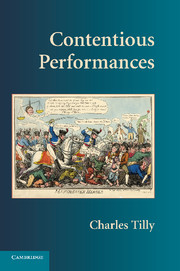Book contents
- Frontmatter
- Contents
- Boxes, Figures, and Tables
- Preface
- Contentious Performances
- 1 CLAIMS AS PERFORMANCES
- 2 HOW TO DETECT AND DESCRIBE PERFORMANCES AND REPERTOIRES
- 3 HOW PERFORMANCES FORM, CHANGE, AND DISAPPEAR
- 4 FROM CAMPAIGN TO CAMPAIGN
- 5 INVENTION OF THE SOCIAL MOVEMENT
- 6 REPERTOIRES AND REGIMES
- 7 CONTENTION IN SPACE AND TIME
- 8 CONCLUSIONS
- References
- Index
8 - CONCLUSIONS
Published online by Cambridge University Press: 05 June 2012
- Frontmatter
- Contents
- Boxes, Figures, and Tables
- Preface
- Contentious Performances
- 1 CLAIMS AS PERFORMANCES
- 2 HOW TO DETECT AND DESCRIBE PERFORMANCES AND REPERTOIRES
- 3 HOW PERFORMANCES FORM, CHANGE, AND DISAPPEAR
- 4 FROM CAMPAIGN TO CAMPAIGN
- 5 INVENTION OF THE SOCIAL MOVEMENT
- 6 REPERTOIRES AND REGIMES
- 7 CONTENTION IN SPACE AND TIME
- 8 CONCLUSIONS
- References
- Index
Summary
In the noisy, smelly, turbulent, visually vibrant London of the 1760s, John Wilkes's supporters had no idea that they were helping to create the social movement. As they marched, rallied, and petitioned, however, they knew that they and their hero were pushing the limits of available contentious performances. They centered their claims on public officials, London electors, and Parliament. To that extent they broke with Britain's prevailing parochial, particular, and bifurcated 18th-century repertoire of contention. In comfortable retrospect, we 21st-century observers can think of them as pointing toward the combination of campaigns, performances, and WUNC displays (public enactments of worthiness, unity, numbers, and commitment) we call the social movement. We can therefore conclude that they were helping craft cosmopolitan, autonomous, and modular repertoires. From their own perspective, however, they were opposing tyranny and asserting their collective rights. Our analysis is retrospective; theirs was prospective.
The tension between retrospective and prospective analysis drives this book. On one side, we seek retrospectively to explain how changes in performances and repertoires occur. Chapter 4, for instance, used a comparison of London's Wilkes and Gordon mobilizations (1768 and 1780) to show how the outcome of one campaign affects the shape of the next campaign. On the other side, we seek prospectively to show how previously existing performances and repertoires shape the ways that people make collective contentious claims.
- Type
- Chapter
- Information
- Contentious Performances , pp. 200 - 212Publisher: Cambridge University PressPrint publication year: 2008

